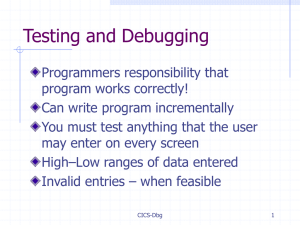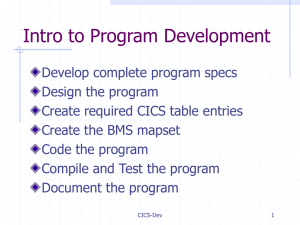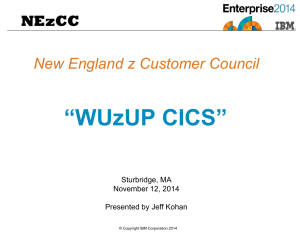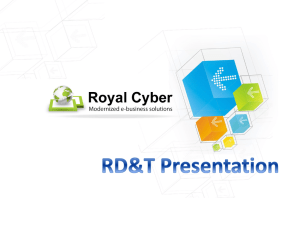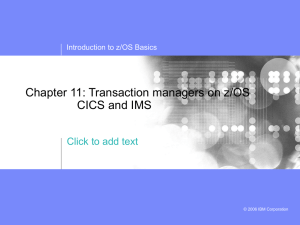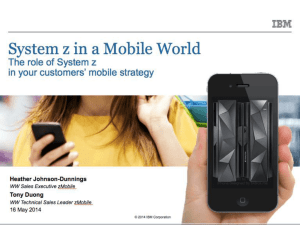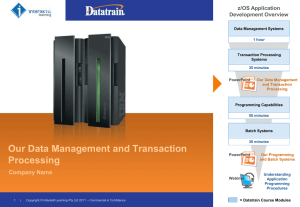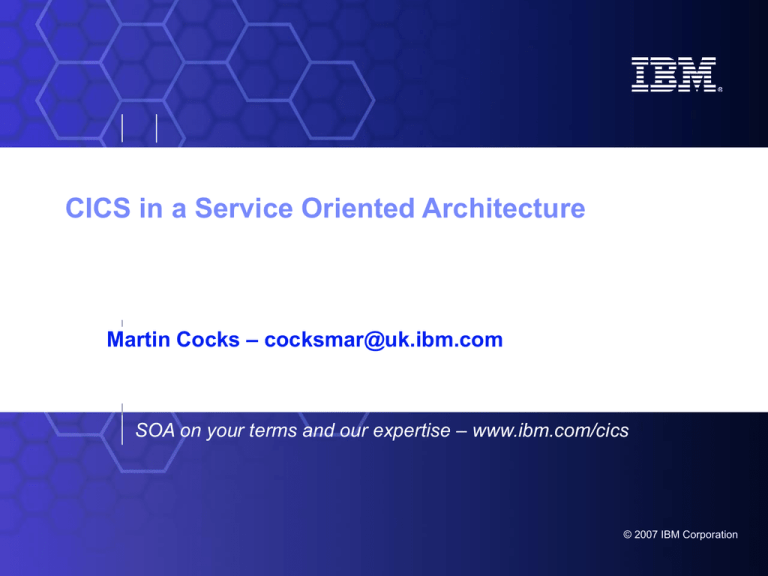
CICS in a Service Oriented Architecture
Martin Cocks – cocksmar@uk.ibm.com
SOA on your terms and our expertise – www.ibm.com/cics
© 2007 IBM Corporation
© IBM Corporation 2008. All Rights Reserved.
The workshops, sessions and materials have been prepared by IBM or the session speakers and reflect their own views. They are
provided for informational purposes only, and are neither intended to, nor shall have the effect of being, legal or other guidance or
advice to any participant. While efforts were made to verify the completeness and accuracy of the information contained in this
presentation, it is provided AS IS without warranty of any kind, express or implied. IBM shall not be responsible for any damages arising
out of the use of, or otherwise related to, this presentation or any other materials. Nothing contained in this presentation is intended to,
nor shall have the effect of, creating any warranties or representations from IBM or its suppliers or licensors, or altering the terms and
conditions of the applicable license agreement governing the use of IBM software.
References in this presentation to IBM products, programs, or services do not imply that they will be available in all countries in which
IBM operates. Product release dates and/or capabilities referenced in this presentation may change at any time at IBM’s sole discretion
based on market opportunities or other factors, and are not intended to be a commitment to future product or feature availability in any
way. Nothing contained in these materials is intended to, nor shall have the effect of, stating or implying that any activities undertaken
by you will result in any specific sales, revenue growth or other results.
Performance is based on measurements and projections using standard IBM benchmarks in a controlled environment. The actual
throughput or performance that any user will experience will vary depending upon many factors, including considerations such as the
amount of multiprogramming in the user's job stream, the I/O configuration, the storage configuration, and the workload processed.
Therefore, no assurance can be given that an individual user will achieve results similar to those stated here.
All customer examples described are presented as illustrations of how those customers have used IBM products and the results they
may have achieved. Actual environmental costs and performance characteristics may vary by customer.
The following are trademarks of the International Business Machines Corporation in the United States and/or other countries. For a
complete list of IBM trademarks, see www.ibm.com/legal/copytrade.shtml
AIX, CICS, CICSPlex, DB2, DB2 Universal Database, i5/OS, IBM, the IBM logo, IMS, iSeries, Lotus, OMEGAMON, OS/390, Parallel Sysplex,
pureXML, Rational, RACF, Redbooks, Sametime, Smart SOA, SupportPac, System i, System i5, System z , Tivoli, WebSphere, and z/OS.
Java and all Java-based trademarks are trademarks of Sun Microsystems, Inc. in the United States, other countries, or both.
Microsoft and Windows are trademarks of Microsoft Corporation in the United States, other countries, or both.
Intel and Pentium are trademarks or registered trademarks of Intel Corporation or its subsidiaries in the United States and other
countries.
UNIX is a registered trademark of The Open Group in the United States and other countries.
Linux is a registered trademark of Linus Torvalds in the United States, other countries, or both.
Other company, product, or service names may be trademarks or service marks of others.
CICS in a Service Oriented Architecture | www.ibm.com/cics
Agenda
CICS TS V3 and SOA Overview
Pipeline and WS-* support
– MTOM/XOP
– WS-AT
– WS-Security
– WS-Trust
3
CICS in a Service Oriented Architecture | www.ibm.com/cics
Web Services in CICS
SOA on your terms and our expertise – www.ibm.com/cics
© 2007 IBM Corporation
Web Services at a glance in Version 3
CICS TS V3.1
CICS TS V3.2
The runtime support in CTS 3.1 is for
Support was added for
– WSDL 1.1
– WSDL 2.0
– SOAP 1.1 and SOAP 1.2
– MTOM/XOP
– WS-I Basic Profile 1.1
– WS-Trust
– XML 1.0
– Additional schema data mappings
– WS-I Simple SOAP Binding Profile 1.0
– WS-AT 1.0
– WS-Security 1.0
• Provides batch tooling to handle
generation of data mappings
– Schema into (and vice-versa)
• C
• Pl/I
• Cobol
5
CICS in a Service Oriented Architecture | www.ibm.com/cics
Usage Scenarios
CICS as a Service Provider using existing program (bottom up)
• Existing application not changed
– Existing language structure
CICS as a Service Provider using new program (top down)
• New application
– Existing WSDL
CICS as a Service Requester using a new program (top down)
• New application
– Existing WSDL
6
CICS in a Service Oriented Architecture | www.ibm.com/cics
Web Services Enablement Styles
Bottom-up
Top-down
New service: WSDL
Existing service
description WSDL
Generate
Existing
Business App
(e.g. COBOL, C, C++, PLI)
7
Generate
New
Business App (COBOL,
C, C++, PLI)
CICS in a Service Oriented Architecture | www.ibm.com/cics
Meet in the middle
Existing service
description WSDL
Map and
Generate
Existing
Business App
(COBOL, C, C++, PLI)
http://www.mycics.co.uk/webservice
Pipeline 1
Pipeline 2
Soap
Message
Pipeline 3
URIMAP
8
CICS in a Service Oriented Architecture | www.ibm.com/cics
CICS
Application
CICS
Application
CICS
Application
CICS
Application
CICS
Application
Tooling to Runtime (the connection)
• CICS provides the necessary tools and runtime for web services
• A utility can generate WSDL from language structures
– a bottom up approach from an existing application
• A utility can generate language structures from WSDL
– a top down approach to new CICS service provider or
requester programs
• XML to language structure (e.g. COMMAREA) conversion and vice
versa at runtime
• The link between the utilities and the runtime is via the WSBind file
9
CICS in a Service Oriented Architecture | www.ibm.com/cics
Web Services (the complete picture)
top down
Tools
IDE tools
WSDL
bottom up
CICS provided
utilities
WSBind
file
lang.
structure
CICS Web service
Runtime
Service
Requester
pipeline
conversion
Business
logic
CICS
10
CICS in a Service Oriented Architecture | www.ibm.com/cics
Runtime Scenarios
• CICS can be the service provider
– traditional situation. CICS is the server in a client/server
scenario. A client sends a request in to CICS.
• CICS can be the service requester
– this is where CICS is the client in the client/server scenario.
CICS is sending a request to execute a webservice to an
external service provider.
11
CICS in a Service Oriented Architecture | www.ibm.com/cics
Provider overview
Conversion
Convert to
SOAP
Body
commarea
Inbound
format and
invoke app
Pipeline
CICS
application
SOAP
Body
Outbound
Convert to
SOAP and
pass to
pipeline
12
CICS in a Service Oriented Architecture | www.ibm.com/cics
program
Requester overview
Conversion
CICS Application
Convert to
SOAP
Body
Outbound
Program
SOAP and
pass to
pipeline
EXEC CICS INVOKE
Pipeline
WEBSERVICE
SOAP
Body
Inbound
Convert to
commarea
format and
pass to
application
13
CICS in a Service Oriented Architecture | www.ibm.com/cics
QoS handlers and support
14
CICS in a Service Oriented Architecture | www.ibm.com/cics
MTOM/XOP support in CICS
• CICS now supports MTOM/XOP over HTTP transport
• MTOM handler added at transport end of pipeline
– Handles packaging and unpackaging of MIME root and
attachments
– Attachments are stored as containers of data type BIT
– List of attachments is stored in a separate container
• Pipeline usually processes message in XOP format
instead of XML
– Application handler works with attachments instead of
base64Binary data
15
CICS in a Service Oriented Architecture | www.ibm.com/cics
XOP processing modes
Two ways in which XOP messages can be processed:
• Direct mode
– Pass message along pipeline in XOP format, using
application handler logic to deal directly with attachments.
– This is the normal mode which fully exploits the MTOM/XOP
optimization.
• Compatibility mode
– Pass message along pipeline in standard XML format,
converting to and from XOP format as part of the MTOM
handler processing.
– This mode is used to tolerate the use of MTOM/XOP when
WS-security or XML validation is being used.
16
CICS in a Service Oriented Architecture | www.ibm.com/cics
CPU per msg
Requester Web Services with binary data and
MTOM/XOP
225
200
175
150
125
100
75
50
25
0
0
250
500
750
Binary element size in K
CTS31
17
CTS32
CTS32 MTOM/XOP
CICS in a Service Oriented Architecture | www.ibm.com/cics
1000
MTOM/XOP Performance summary
• Performance improvements with binary data and
MTOM/XOP
– CPU benefits for binary data
• 53% less CPU for a 1 meg binary element compared with CICS
TS V3.1
– CPU benefits for MTOM/XOP
• MTOM/XOP gives performance benefits for binary data > 4K
• 88% less CPU for a 1 meg binary element compared with nonMTOM/XOP
• 94% less CPU for a 1 meg binary element compared with CICS
TS V3.1
– Reduced network transmission size
• 25% less data transmitted for a 1 meg binary element using
MTOM/XOP
18
CICS in a Service Oriented Architecture | www.ibm.com/cics
WS-AT Support
• Allows CICS to be both a Coordinator and
Participant in distributed 2 phase commit over
Web Services
• Bi-directional
• Uses underlying CICS Recovery manager
services
19
CICS in a Service Oriented Architecture | www.ibm.com/cics
WS-AT 1.0 Example
W
ebSphereApplicationServer V6
CICSTS
80.27.16.238
129.35.161.66
W
SATFaultPort
8.Com
m
itted
Coordinator
RSRequester pipeline
(DFHW
SATR)
6.Prepared
Registration
and
Protocol
services
(DFHPIRS)
2.Register
RegistrationCoordinator
3.RegisterResponse
Port
5.Prepare
7.Com
m
it
DFHW
SATX
RSProvider pipeline
(DFHW
SATP)
Servlet
JSPs
EJBs
20
1. InvokeW
Sw
ith
CoordinationContext
DFHW
SATH
4. W
Sresponse
W
SProvider pipeline
CICS in a Service Oriented Architecture | www.ibm.com/cics
W
ebservice
provider app
WS-Security 1.0 Overview
• Support for
– XML Encryption
– XML Digital Signature
– Identity mapping and asserted identity
• Uses ICSF for crypto hardware support
• Requires XML Toolkit for C
21
CICS in a Service Oriented Architecture | www.ibm.com/cics
WS-Trust Support
• Establishing an identity for a web service request in
CICS to run under.
– This means an 8 character userid
– External / client identities are often not part of the same
security database or even of the same type.
• Adding credentials to a message when CICS is
sending a Web Services request such that it runs
under the correct identity in providing system
– CICS only has an 8 character view of the identity and no
access to the password
– External systems often use other formats
22
CICS in a Service Oriented Architecture | www.ibm.com/cics
WS-Trust Schematic
STS
(Change Security Tokens)
SAML assertion
RACF userid token
SOAP Envelope
SOAP Header
Header Block
Header Block
SOAP Body
Body sub-element
23
Pipeline
(Trust Handler)
SOAP Envelope
SOAP Header
Header Block
Header Block
SOAP Body
Body sub-element
Body sub-element
Body sub-element
Body sub-element
Body sub-element
CICS in a Service Oriented Architecture | www.ibm.com/cics
WS-Security – Provider Basic Authentication
L
S
S
h+
+A
ut
+A
ut
h
CTS31
CTS32
+S
S
L
S
O
A
P
14
12
10
CPU
8
millisecs
6
per msg
4
2
0
24
CICS in a Service Oriented Architecture | www.ibm.com/cics
WS-Trust – Provider and Requester
4.5
4
3.5
3
CPU
2.5
millisecs
2
per msg 1.5
1
0.5
0
No
Trust
SSL
Requester
25
Trust
STS
SSL
Provider
CICS in a Service Oriented Architecture | www.ibm.com/cics
SSL
Application Bindings
WSDL/Schema
26
CICS in a Service Oriented Architecture | www.ibm.com/cics
WSDL
definition
type
• Web Services Description Language
• XML based language to describe an
interface of a service
• WSDL comprises of
–
–
–
–
–
–
–
27
type
portType
message
operation
binding
service
port
message
abstract
service
interface
definition
portType
operation
Input
Output
how the
service is
implemented
binding
location of
service
service
CICS in a Service Oriented Architecture | www.ibm.com/cics
port
Bottom up approach in CICS TS V3
•An existing CICS application is to be exposed as a
web service
– Language structure(s) need to be extracted from the source
code
– If the COMMAREA is very complex, it may be necessary to
write a ‘wrapper program’ to map the COMMAREA into a form
which can be handled by the CICS tooling.
– Use a CICS supplied batch procedure (DFHLS2WS) to
convert language structure(s) to WSDL.
• The language structures can be COBOL, PL/I, C or C++
• Publish the generated WSDL, using WSRR for example.
• A file called the WSBind file is also produced.
28
CICS in a Service Oriented Architecture | www.ibm.com/cics
Batch Processing (DFHLS2WS)
Language
structure(s)
JCL to specify
parameters
29
05 WSTEST2.
10 Wrapper.
15 SOME-DATA
15 USER-DETAILS.
20 FIRST-NAME
20 LAST-NAME
20 AGE
PIC X(79).
PIC X(10).
PIC X(10).
PIC 9(3) DISPLAY.
//JAVAPROG EXEC DFHLS2WS,
LOGFILE=/u/myuserid/wsbind/ls2ws.log
WSDL=/u/myuserid/wsdl/temp.wsdl
PGMNAME=PETS
URI=/reqpetsURI
PGMINT=CHANNEL
CONTID=mycontname
LANG=COBOL
WSBIND=/u/myuserid/wsbind/reqpet.wsbind
PDSLIB=//MYUSERID.COPYBOOK
REQMEM=INPUT01
CICS in a Service Oriented Architecture | www.ibm.com/cics
WSBind file
WSDL
The previous foil showed an overview of the batch process when starting from a language structure (or
several language structures) and converting them into a WSDL document. The WSDL generated by
the CICS tooling will always be Document literal.
The WSBind file is also produced.
30
CICS in a Service Oriented Architecture | www.ibm.com/cics
Top down approach in CICS TS V3
•A supplied WSDL definition of a web service is to be
implemented as a CICS application
– Use
CICS supplied batch procedure (DFHWS2LS) to
convert the WSDL into a language structure.
• Use the generated language structure in a CICS application
program.
• A file called the WSBind file is also produced.
31
CICS in a Service Oriented Architecture | www.ibm.com/cics
Batch Processing (DFHWS2LS)
Schema
JCL to specify
parameters
32
<xsd:element name="SOME-MESSAGE" nillable="false">
<xsd:simpleType>
<xsd:restriction base="xsd:string">
<xsd:length value="79"/>
<xsd:whiteSpace value="preserve"/>
</xsd:restriction>
</xsd:simpleType>
</xsd:element>
<xsd:element name="NAME" nillable="false">
<xsd:simpleType>
<xsd:restriction base="xsd:string">
<xsd:length value="20"/>
<xsd:whiteSpace value="preserve"/>
</xsd:restriction>
</xsd:simpleType>
</xsd:element>
//JAVAPROG EXEC DFHWS2LS,
LOGFILE=/u/myuserid/wsbind/wstest1.log
WSDL=/u/myuserid/wsdl/wstest1.wsdl
BINDING=WSTEST1HttpSoapBinding
PGMNAME=WSTEST1
URI=/wstest1
PGMINT=COMMAREA
LANG=COBOL
WSBIND=/u/myuserid/wsbind/wstest1.wsbind
PDSLIB=//MYUSERID.COPYBOOK
REQMEM=WS1IN
CICS in a Service Oriented Architecture | www.ibm.com/cics
WSBind file
Language
structure(s)
Meet in the middle
• Pure ‘top down’ or ‘bottom up’ will not be suitable in all situations.
• In such situations, a wrapper program may provide a solution
– if the language structure uses data types not supported by the utility
tools
• a wrapper program may be used to map commarea to a supported data type
– when there are unnecessary fields in the language structure which you
do not want to expose externally
• a wrapper program can be used to hide unnecessary fields
– when an existing piece of WSDL is to be used with an existing
program
• the WSDL and the program may not match exactly. A wrapper program could
perform some intermediate mappings.
34
CICS in a Service Oriented Architecture | www.ibm.com/cics
Where a wrapper program fits in
SOAP
body
35
Conversion
Wrapper
Program
Change the
SOAP to a
COMMAREA
Change the
COMMAREA
as required
CICS in a Service Oriented Architecture | www.ibm.com/cics
Business
Logic
Thank you
36
CICS in a Service Oriented Architecture | www.ibm.com/cics


